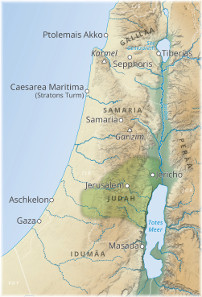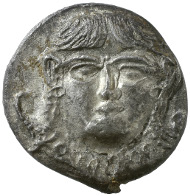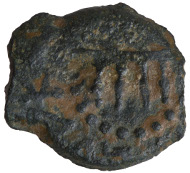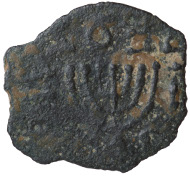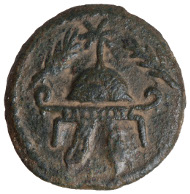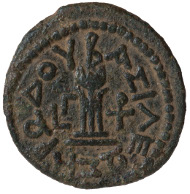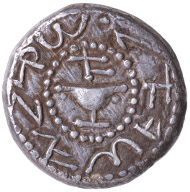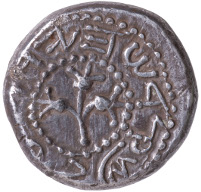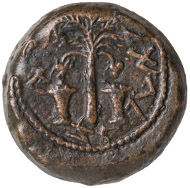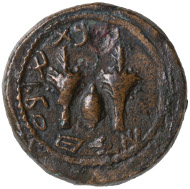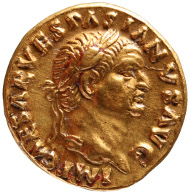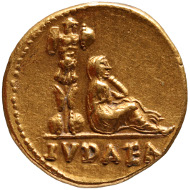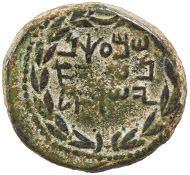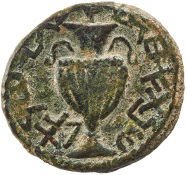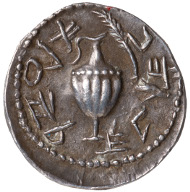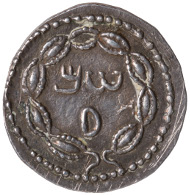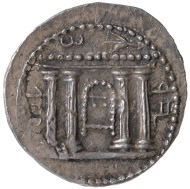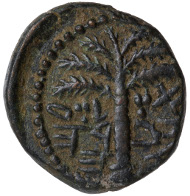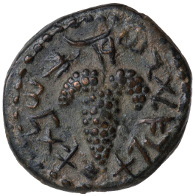April 9, 2015 – The coin collection of the Kunsthistorisches Museum in Vienna presents until September 13, 2015 the exhibition “Coinage and Power in Ancient Israel“. The pieces from the Israel Museum in Jerusalem demonstrate the political and religious changes ancient Israel experienced.
Province of Judaea in the 4th century BC. © Vienna University, IfGR.
The exhibition offers an introduction to the history of ancient Jewish coinage from the 4th century BC to the 2nd century AD. It covers the time from the period under Persian rule to the Hasmonean dynasty to Herod the Great to the First Jewish-Roman War and the Bar Kokhba revolt (AD 132-135) that marked the end of Jewish coinage.
These years brought sweeping political and religious changes for the people of the Jewish world, changes that would deeply influence Jewish culture and religion. The coins on show reflect and document the history of these dramatic centuries and offer insights into the identity and self-image of the Jewish elites.
The exhibition is organized in collaboration with the Israel Museum Jerusalem and the University of Vienna (Department for Numismatic Studies and Department of Geography and Regional Research).
From Persian Rule to the Ptolemaic Kings of Egypt: c. 400-260 BC
So-called Yehud-coinage from the 4th century BC is the earliest extant example of Jewish coinage; they were minted under Persian rule and during the reign of the Ptolemaic kings, who succeeded them.
“Judah” under Persian rule Quarter-Shekel, manufactured at a Philistine mint, 4th century BC. Obverse: Gorgoneion. Reverse: lion killing a bull; Aramaic: Yehud. © Israel Museum, Jerusalem. This is the oldest extant coin with the inscription Judah.
The minting was probably at least partially overseen by the priests of the Temple in Jerusalem, and may have been connected to the annual Jewish poll tax collected by the Temple (Nehmenia 10,33).
From the Maccabean Revolt to the Hasmonean Dynasty (165-37 BC)
At the end of the Fifth Syrian War (202-195 BC) Judah was incorporated into the Seleucid Empire and ruled from Syria. Subsequently, Jewish society was increasingly exposed to Hellenistic influences and ideas, which led to tensions with Orthodox Judaism and subsequently the so-called Maccabean revolt. This and the defeat of the Greek faction formed the basis for the rise of the Hasmonean dynasty. Today Jews still celebrate Hanukkah, observed during the month of Kislev (November/December), to commemorate the rededication of the Temple in Jerusalem following the successful revolt in 164 BC.
Maccabean coinage had to reflect the Jewish ban on images, which is why there are no portraits of rulers. The coins were mainly decorated with Hebraic – sometimes also with Aramaic or Greek – inscriptions. This use of different languages and scripts made it possible to transport specific messages about ethnicity, religion and hierarchical positions in Jewish society.
Antigonos (Mattathyah) Perutah, minted in Jerusalem, 40-37 BC. Obverse: Showbread table; Paleo-Hebrew: Mattityah, the High Priest. Reverse: menorah; Greek: of the King Anti[gonos]. © Israel Museum, Jerusalem. This is the only known depiction of these Jewish ritual objects on a coin.
The coins minted by Antigonus II Mattathyah (40-37 BC), the last Hasmonean king of Judah, depict the menorah and the showbread table, i.e. for the first time two objects from the Temple in Jerusalem. Antigonus chose these images on purpose. They document his inheritance, his just claim as a scion of the Hasmonean dynasty to rule as priest-king, setting him apart from his political adversary, the merely half-Jewish Herod; born to a Nabataean mother, Herod’s ancestry made him unfit to assume the office of high-priest.
Herod the Great (40-4 BC), bronze coin, minted in Samaria 37 BC. Obverse: helmet flanked by two palm branches. Reverse: bowl on a tripod; Greek: of King Herod. © Israel Museum, Jerusalem. Helmet and palm branches symbolize Herod’s power and his victory over the last ruler from the Hasmonean dynasty.
Herod the Great and his Successors (37 BC-c. AD 100)
The conquest of Jerusalem in 37 BC marked the beginning of Herod’s rule, which lasted almost thirty-three years. Herod the Great, Rome’s client king of Judea, helped embed his kingdom in the political structure and hierarchy of the emerging Roman world order – and this is also documented on his coins.
When Herod the Great died in 4 BC, Emperor Augustus divided the former’s kingdom among his three sons. Herod’s grandson, Herod Agrippa I, and great-grandson, Agrippa II, again ruled over a Jewish Empire, although both were Roman vassals. The coins minted by these rulers differ greatly; however, they are all informed by contemporary Hellenistic and Roman coins and only respect the ban on images when it was politically opportune to do so. Roman prefects and procurators issued their own coinage, which also respected the Jewish prohibition of images.
The First Jewish Rebellion. Shekel, minted in Jerusalem, year 1 (AD 66). Obverse: goblet, above it aleph (year 1); Paleo-Hebrew: Shekel of Israel reverse: branch with three pomegranates; Paleo-Hebrew: Jerusalem is sacred. © Israel Museum, Jerusalem.
The First Jewish-Roman War: AD 66-70
Under Herod Agrippa II (AD 53-100), the last scion of the Herodian dynasty, Jewish society was racked by an internal political power struggle between the different religious parties that resulted in something akin to civil war. At the same time unjustified imperial tax demands increased tensions with Rome; when the Roman procurator Gessius Florus looted the Temple treasure, a revolt broke out that was eventually crushed by Emperor Vespasian and his son Titus.
The First Jewish Rebellion. Half-Shekel, minted in Jerusalem, year 4 (AD 69-70). Obverse: palm tree, two baskets with dates, Paleo-Hebrew: For the Deliverance of Zion. Reverse: etrog fruit, two Lulav-bundles; Paleo-Hebrew: year 4, Half[-Shekel]. © Israel Museum, Jerusalem.
The coins minted during the five years of the First Jewish-Roman War are among the best and most beautiful examples of Jewish coinage. The inscriptions on the coins, which, like those minted by the Hasmonean dynasty, use paleo-Hebrew script, illustrate the aims of the Jewish revolution: “Israel’s Shekel”, “Jerusalem the Holy”, “Zion’s Freedom” and “for the liberation of Zion” are some of the watchwords propagated with the help of these coins.
Vespasian (AD 69-79). Aureus, minted in Rome AD 69-70. Obverse: Bust of Vespasian with laurel wreath facing right. Reverse: Mourning Judea seated beside a Tropaion. © KHM.
Following the Roman victory, Judea was turned into a Roman province, with Caesarea Maritima designated as the seat of the proconsul. Titus and his father Vespasian celebrated their victory over the Jews both with a magnificent triumph in Rome and on their coins.
The Second Jewish-Roman War/The Bar Kokhba Revolt: AD 132-135
The Second Jewish War broke out in AD 132; it lasted for over three-and-a-half years and was caused by the continued suppression of the Jews in Palestine following their defeat in the First Jewish-Roman War.
The Second Jewish Rebellion. Bronze coin, minted in Jerusalem, year 1 (AD 132). Obverse: wreath; Paleo-Hebrew: Shimon, Prince of Israel. Reverse: Paleo-Hebrew: year 2 of the deliverance of Jerusalem. © KHM.
It is also known as the Bar Kokhba Revolt, after Simon Bar Kokhba, the leader of the Jewish rebels, who is also recorded in Christian sources.
Second Jewish Rebellion. Zuz, minted in Jerusalem, AD 133. Obverse: ewer; Paleo-Hebrew: Shimeon. Reverse: Paleo-Hebrew: for the freedom of Jerusalem. © Israel Museum, Jerusalem. At times Roman denarii were re-struck; this made the production of planchets obsolete, but they also literally overlay the colonial power, making it unnecessary to spell out the political message.
The revolt was triggered by Emperor Hadrian’s (AD 117-138) plan to re-found Jerusalem, which had been re-named Aelia Capitolina, as a Roman colony and to erect a temple dedicated to Jupiter on the ruins of the Second Temple.
The Second Jewish Rebellion. Sela, minted in Jerusalem, year 1 (AD 132). Obverse: façade of the Temple; Paleo-Hebrew: Jerusalem. Reverse: Lulav-bundle, on the left etrog fruit; Paleo-Hebrew: year 1 of the deliverance of Israel. © Israel Museum, Jerusalem. During the Second Jewish Rebellion, too, large silver coins, which were known as Sela, were struck.
The best-known motif depicted on Bar-Kokhba coinage is the façade of the Temple; it is either a reference to the then no -longer extant Second Temple or to the planned new Third Temple. The reverses feature objects connected with Jewish religious practice in the Temple, for example, lulav and etrog as references to Sukkot.
The Second Jewish Rebellion. Bronze coin, minted in Jerusalem, year 1 (AD 132). Obverse: palm tree; Paleo-Hebrew: Eleazar, the High Priest. Reverse: grapes; Paleo-Hebrew: year 1 of the deliverance of Israel. © Israel Museum, Jerusalem.
The ultimate quashing of the revolt and the destruction of Jerusalem in AD 135 enabled Hadrian to erect a new capital informed by Roman models. Now a temple dedicated to Jupiter occupied the sacred spot where the Jewish Temple had stood. Jews were forced to leave Jerusalem, forbidden to return on pain of death. Thus for many centuries Jerusalem and the Temple were lost as Judaism’s central sanctuary, engendering different intellectual Judaic centres in Palestine and, eventually, throughout the entire classical world.
More information on the exhibition provides the website of the Museum.
To get to the online exhibition catalogue please click here.
You may find there a lot of maps …
… all coins …
… the showcases …
… and interesting movies.
The website of the Israel Museum in Jerusalem is very interesting too.
And make sure to read Haim Gitler’s Introduction on The History of the Numismatic Department at the Israel Museum.
A detailed article on the “First Jewish Coin” you can read in CoinsWeekly.
More articles on the same topic you may find in our archive.
And last but not least: This CoinsWeekly article tells you more about “Numismatics in Jerusalem”.




